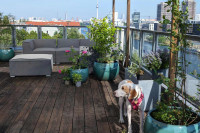How you as a company can promote biodiversity
by Daniel Schlee
New growth on our roof terrace
We take new growth very seriously, even on a small scale - for example on our roof terrace. We designed it to be nature-friendly under the guidance of our sustainability expert Daniel Schlee. In this way, we have not only created a place for creative freedom, but have also actively contributed to the promotion of biodiversity.
Biodiversity is important for the resilience and adaptability of ecosystems and is therefore a key element for the preservation and health of our planet.
And every individual can do something for this on a small scale. For example, on the company premises. We have designed our roof garden to be sustainable and nature-friendly. However, there was a lot to consider, as it also had to meet many other requirements.
Daniel Schlee
diffferent, Sustainability expert
We wanted to create a place where employees and customers can work and linger creatively.
More than 85% of our plant selection consists of native perennials and shrubs from sustainable and local sources. These are valuable for a variety of animals, including 36 bird species, 201 wild bees and 437 butterflies.
The free platform “NaturaDB” helps you to select biodiversity-friendly plants. Here you can find out which plants are particularly useful for which insects and animals.
External conditions such as sun, heat, wind, limited root space and growth height or the robustness of the plants must also be taken into account from the outset.
We were faced with the following requirements and challenges:
- Sustainability: we wanted a biodiversity-promoting, i.e. native and site-appropriate plant selection from sustainable and local sources.
- Extreme conditions: On our roof terrace, the plants are exposed to a lot of sun, heat and wind and only have limited root space available.
- Landlord's requirements: The plants must be highly robust for roof safety and have a low growth height.
- Representative effect: The plants should meet aesthetic requirements and not appear too wild.
- Functional requirements: The plants should be perennial, require little care and have a low water requirement.
Many garden centers and DIY stores offer pretty, but usually short-lived and ecologically inferior cultivars and neophytes. Our sustainability expert Daniel Schlee did not want to support this “fast fashion for the garden”. At the same time, the selected native wild plants should also be aesthetically pleasing and create a representative arrangement. The result was a “best of both worlds” approach.
Ultimately, it was a joint project involving various employees who were involved in the planning and implementation of the measures. We had to coordinate our individual preferences and viewing habits and get creative in order to meet all requirements.
This cultural project not only brought us closer together as a team and strengthened our identification with our workplace, but also gave us the opportunity to engage more intensively and vividly with biodiversity.
We are happy to receive project inquiries



